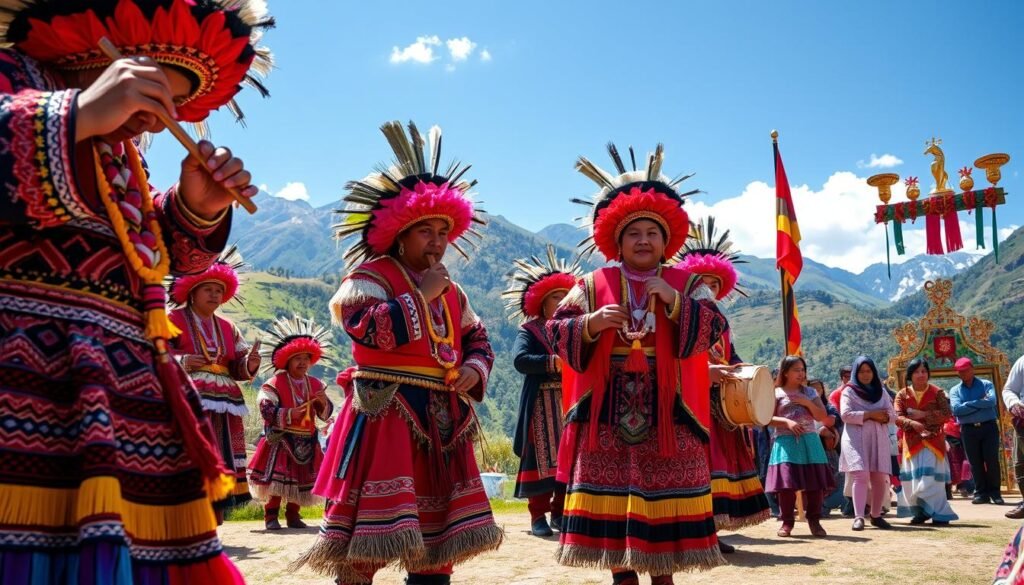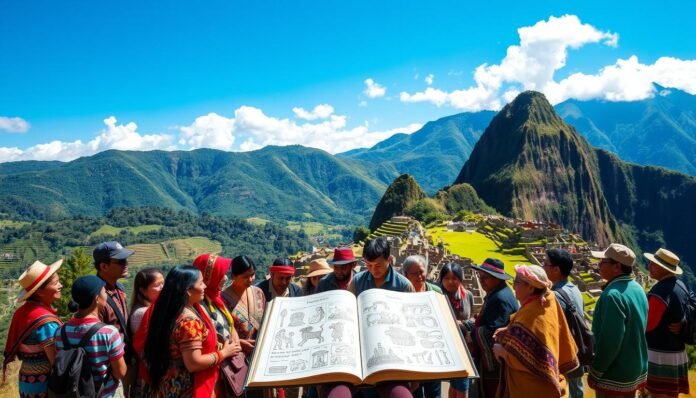Quechua is an old and lively language. It connects communities in Peru, Bolivia, Ecuador, Colombia, and Argentina. It has many dialects, each with its own sounds, words, and ways of speaking.
The idea of “Wayqear pegar entre varios Quechua” is to bring these dialects together. It aims to keep the heart of Quechua culture alive.
This article explores the world of Quechua dialects. It shows how important it is to connect them. It talks about education, media, and cultural events that help bridge the language gaps.
By learning about the Quechua language, we can see its lasting value. It helps us understand the rich culture of the Andean region.
Understanding the Rich Heritage of Quechua Language Dialects
Quechua is a family of languages with many dialects. These dialects are shaped by local history, geography, and culture. Each one has its own special way of speaking, with different grammar, sounds, and words.
In Cusco, the Quechua spoken is very different from the Quechua in Northern Peru or Bolivia. These differences show how important the language is to each area. They can also make it hard for people from different places to talk to each other.
Quechua dialects show the language’s rich diversity. Each one carries the stories, traditions, and words of its community. Keeping these dialects alive is a source of pride for many Quechua speakers. They see it as a key part of their cultural heritage.
There are efforts to teach and save Quechua. Some work to make the language more standard. But they also help keep local dialects alive. With media and technology, people from all over can connect and celebrate their shared language.
The Concept of Wayqear Pegar Entre Varios Quechua
“Wayqear Pegar Entre Varios Quechua” is a movement to unite Quechua language dialects. It aims to help people from different areas speak Quechua easily. This way, they can share their culture and language.
This idea wants to make cultural bonds stronger. It also helps keep the Quechua language alive. With programs and tools, they’re making it easier for people to talk across dialects.
The work behind Wayqear Pegar is based on Quechua values like ayni and minka. These values mean working together and helping each other. By doing this, Quechua communities are building strong connections. They’re keeping their language and culture alive.
Bridging Communication Gaps Between Quechua Communities
It’s important to talk and understand each other in Quechua communities. Bilingual education helps by teaching different Quechua dialects. This way, we respect the language’s heritage and make talking easier.
Media and tech are great for connecting people. Radio, podcasts, and TV shows mix different Quechua dialects. Social media lets people talk across dialects, sharing culture and understanding.
Language apps and digital dictionaries help too. They offer many Quechua dialects. This makes it easier for speakers to use the language.
Standardizing some parts of Quechua is also key. It keeps the language’s diversity alive. This way, we can all talk and work together better.
Educational Initiatives and Language Preservation
Keeping Quechua language dialects alive is key in education. Schools teach both local and standard Quechua. This helps students understand their own dialect and talk with others.
There are many tools to help learn Quechua. Bilingual books, apps, and online classes are popular. Schools in Quechua areas now offer bilingual programs. This helps students love and respect their native language.
These steps support the fight to keep Quechua alive. It’s about keeping the culture and language alive for the next generations. By teaching both local and standard Quechua, we aim to keep the language strong and connected.
Technology’s Role in Uniting Quechua Speakers
Technology is a big help in connecting Quechua speakers. It uses apps, digital dictionaries, and social media. These tools help people talk across different areas.
Apps and digital tools are key. They let people see the differences in Quechua. Social media helps people share and learn from each other. This builds a strong community.
Radio, podcasts, and TV in Quechua mix different ways of speaking. This makes listeners more flexible and understanding. It shows the beauty of Quechua’s many voices.
These tools are very important for Quechua. They help keep the language alive and strong. With apps, digital tools, and social media, Quechua is becoming more united and proud.
Cultural Events and Community Integration
Quechua festivals and cross-community exchanges help people understand each other better. They celebrate the Quechua identity and the many languages in the Andean region. By joining in, people from different Quechua dialects share their words, learn, and feel proud together. This is all thanks to cultural pride.
These celebrations are key in bringing Quechua-speaking communities closer. They help people see the beauty and depth of their language. The 
At these events, people celebrate their language and talk to each other. They share knowledge and ideas, feeling like they belong together. This way, the Quechua language and traditions stay alive and strong.
Conclusion
The “Wayqear pegar entre varios quechua” movement shows the strength of the Quechua-speaking community. It celebrates the many ways Quechua can be spoken. This helps everyone understand each other better.
This way, Quechua speakers keep their language alive. It’s not just for talking, but also for showing who they are. By using new tech and learning programs, they teach others to keep their culture alive.
This movement is a great example of how to keep languages and cultures alive. It shows that Quechua unity, linguistic diversity, cultural preservation, and indigenous language empowerment can work together. This keeps the Quechua language strong and connects the community even more.
